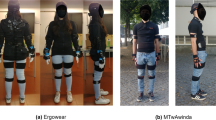Abstract
We propose a method for human full-body pose tracking from measurements of wearable inertial sensors. Since the data provided by such sensors is sparse, noisy and often ambiguous, we use a compound prior model of feasible human poses to constrain the tracking problem. Our model consists of several low-dimensional, activity-specific motion models and an efficient, sampling-based activity switching mechanism. We restrict the search space for pose tracking by means of manifold learning. Together with the portability of wearable sensors, our method allows us to track human full-body motion in unconstrained environments. In fact, we are able to simultaneously classify the activity a person is performing and estimate the full-body pose. Experiments on movement sequences containing different activities show that our method can seamlessly detect activity switches and precisely reconstruct full-body pose from the data of only six wearable inertial sensors.
Access this chapter
Tax calculation will be finalised at checkout
Purchases are for personal use only
Preview
Unable to display preview. Download preview PDF.
Similar content being viewed by others
References
Urtasun, R., Fleet, D., Fua, P.: 3d people tracking with gaussian process dynamical models. In: CVPR (June 2006)
Elgammal, A., Lee, C.: The role of manifold learning in human motion analysis. In: Human Motion Understanding, Modeling, Capture and Animation, pp. 1–29 (2008)
Bandouch, J., Engstler, F., Beetz, M.: Accurate human motion capture using an ergonomics-based anthropometric human model. In: Perales, F.J., Fisher, R.B. (eds.) AMDO 2008. LNCS, vol. 5098, pp. 248–258. Springer, Heidelberg (2008)
Agarwal, A., Triggs, B., Montbonnot, F.: Recovering 3d human pose from monocular images. PAMI 28(1), 44–58 (2006)
Weikert, M., Motl, R.W., Suh, Y., McAuley, E., Wynn, D.: Accelerometry in persons with multiple sclerosis: Measurement of physical activity or walking mobility? Journal of the neurological sciences 290(1), 6–11 (2010)
Belkin, M., Niyogi, P.: Laplacian eigenmaps for dimensionality reduction and data representation. Neural Computation 15(6), 1373–1396 (2003)
Lu, Z., Carreira-Perpinan, M., Sminchisescu, C.: People tracking with the laplacian eigenmaps latent variable model. In: NIPS (January 2007)
Datta, A., Sheikh, Y., Kanade, T.: Modeling the product manifold of posture and motion. In: THEMIS Workshop (2009)
Deutscher, J., Reid, I.: Articulated body motion capture by stochastic search. IJCV 61(2), 185–205 (2005)
Jaeggli, T., Koller-Meier, E., van Gool, L.: Learning generative models for multi-activity body pose estimation. IJCV 83, 121–134 (2009)
Wang, J., Fleet, D., Hertzmann, A.: Gaussian process dynamical models for human motion. PAMI, 283–298 (2008)
Kanaujia, A., Sminchisescu, C., Metaxas, D.: Spectral latent variable models for perceptual inference. In: ICCV, pp. 1–8 (2007)
Isard, M., Blake, A.: A mixed-state condensation tracker with automatic model-switching. In: ICCV, pp. 107–112 (1998)
Roetenberg, D., Slycke, P., Veltink, P.: Ambulatory position and orientation tracking fusing magnetic and inertial sensing. IEEE Transactions on Biomedical Engineering 54(4), 883–890 (2007)
Vlasic, D., Adelsberger, R., Vannucci, G., Barnwell, J.: Practical motion capture in everyday surroundings. In: ACM TOG (2007)
Slyper, R., Hodgins, J.: Action capture with accelerometers. In: ACM SIGGRAPH Symposium on Computer Animation, pp. 193–199 (2008)
Isard, M., Blake, A.: Condensation—conditional density propagation for visual tracking. IJCV (1998)
Author information
Authors and Affiliations
Editor information
Editors and Affiliations
Rights and permissions
Copyright information
© 2010 Springer-Verlag Berlin Heidelberg
About this paper
Cite this paper
Schwarz, L.A., Mateus, D., Navab, N. (2010). Multiple-Activity Human Body Tracking in Unconstrained Environments. In: Perales, F.J., Fisher, R.B. (eds) Articulated Motion and Deformable Objects. AMDO 2010. Lecture Notes in Computer Science, vol 6169. Springer, Berlin, Heidelberg. https://doi.org/10.1007/978-3-642-14061-7_19
Download citation
DOI: https://doi.org/10.1007/978-3-642-14061-7_19
Publisher Name: Springer, Berlin, Heidelberg
Print ISBN: 978-3-642-14060-0
Online ISBN: 978-3-642-14061-7
eBook Packages: Computer ScienceComputer Science (R0)




